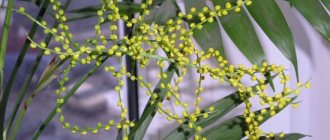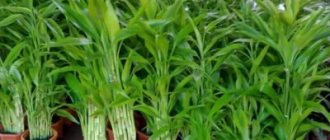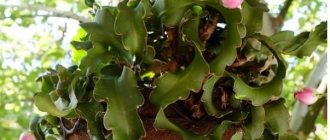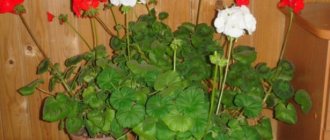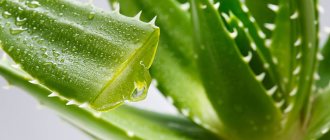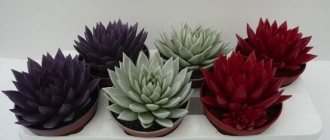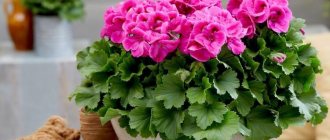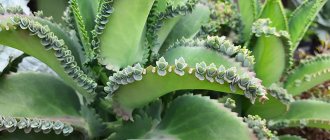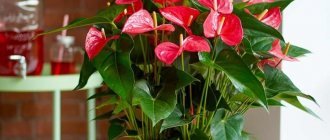General information
The plant has unusual hard, round-oval, green glossy leaf blades with a spike at the end. The inflorescences are white, large, exuding a pleasant aroma during flowering.
In addition to beautiful flowers and decorative appearance, the crop can please you with medium orange-red fruits that are similar to plums. They can be eaten. The fruits have a sweet and sour pleasant taste.
Indoor plum is ideal for growing at home. This spectacular crop is absolutely not capricious and undemanding to care for, which means even novice gardeners can acquire it.
Description of the plant
The shrub comes from hot South Africa and Asia, and is now cultivated in India, Israel, the USA, etc.
Hard leaves are oval-shaped, glossy, juicy green, with a sharp thorn at the base. There are more than 35 species, but about a dozen are used.
Snow-white flowers up to 5 cm in diameter. Carissa blooms almost all the time. Tubular flowers with 5 petals can be white (pink). Carissa flowers can be either solitary or in small inflorescences. The flowers are similar to jasmine sambac, but with less fragrance.
Very tasty reddish fruits that are suitable for food. The fruits are similar in appearance to cream and have a pleasant taste. The size of the fruit varies from variety to 1.5-6 cm.
Varieties with greater fruiting have been developed:
- Fancy;
- Torey Pines;
- Gifford.
These varieties are small in size and have large yields, with large fruits.
Grandiflora is very popular - it is grown indoors more often than others.
Carissa types and varieties with photos
Carissa Variegate - the shrub reaches a height of 50 to 100 centimeters. It differs from other varieties in its variegated, oval leaf blades with a glossy surface and small spines at the ends. The inflorescences of the culture are white with a pleasant aroma. After flowering, small light red fruits are formed in taste and aroma, reminiscent of plums. However, at home, fruiting of this variegated plant is rarely achieved.
Carissa Large-fruited - the shrub can reach up to 4 meters in length and has a highly branched crown. The leaf blades are leathery, dark green, round, dense with spines at the ends. The inflorescences are large, star-shaped, white in color with a pleasant aroma. The crop blooms from May to September. The fruits of the plant resemble plums, are medium in size, have a pomegranate hue and a sweet and sour taste. They ripen from September to October.
Carissa Edible is a fast-growing, evergreen shrub, reaching a height of up to 3 meters. The plant has a wide crown. The branches of the crop are covered with thorns. The leaf blades are dark green, leathery, glossy, oval. The inflorescences are tubular, white in color. Flowering time continues all year round, but its peak occurs between May and September. The crop bears fruit with bright crimson fruits with juicy pulp that tastes like strawberries.
Carissa grandiflora
It is a fruit-bearing evergreen shrub native to South Africa. The plant reaches a height of up to 5 meters and has a highly branched crown. The leaf blades are dark green, oval, glossy. The inflorescences are white with a pleasant aroma. The fruits are oblong, small, red in color with juicy pulp.
Carissa indoor plum is a plant variety suitable for indoor growing. It reaches a height of up to 100 centimeters. It has glossy, leathery, oval, dark green leaf blades. The inflorescences have a white tint and a pleasant aroma. Flowering time lasts from May to September. The crop bears red, juicy, small oval fruits that ripen in October.
Carissa Karanda - in natural conditions the shrub reaches a height of up to 5 meters. It has a strongly branching crown and branches with strong thorns. The leaf blades are elliptical, leathery, glossy, dark green. The flowers are tubular, white-pink in color with a pleasant jasmine aroma. The fruits are medium-sized, red in color with juicy, sour-bitter pulp and brown, flat seeds inside.
Carissa Macrocarpa
A shrub reaching a height of up to 5 meters and having a dense, spreading crown with prickly, numerous branches. The leaves are oval, leathery, dark green, glossy. The inflorescences are tubular, white in color with a sweet jasmine aroma. The fruits are small, purple in color, with juicy pulp and flat seeds.
Carissa Bispinosa - the plant can reach a height of up to 3 meters. The shrub has oval, leathery, glossy leaf blades, dark green in color with pointed ends. The inflorescences are medium-sized, white in color with a strong pleasant aroma. The fruits are small, coral in color with juicy, sour flesh.
Carissa Spinarum - grows wild in Africa and Australia. It reaches a height of up to 5 meters. It has leathery, glossy, oval leaf blades with spines at the ends. The inflorescences are large, tubular with long white petals with a pleasant, persistent aroma. The fruits are medium dark purple with sweet and sour pulp.
Carissa Tetramera - grows wild in Zimbabwe, Tanzania and Mozambique. It reaches a height of up to 3 meters and has a dense, wide crown. The leaf blades are leathery, dark green, glossy, oval with a spine at the end. The inflorescences are tubular, white-pink with a persistent, pleasant aroma. The fruits are bright red, medium-sized with juicy sweet and sour pulp and dark brown seeds.
A little about the plant and its types
Basically, carisa is a small shrub up to one meter high. There are 35 different species of the genus Carissa in nature. They grow mainly in the tropics of Asia, Australia and Africa. Breeders have long been successful in creating new plant varieties. The main focus was on increasing fruiting. This has led to the development of high-yielding varieties such as Gifford, Torrey Pines and Fancy, which produce large fruit.
But it is interesting not only as a fruit, but also as an ornamental plant. For this reason, breeders have focused their efforts on improving the decorative qualities of carissa. This led to more intense branching and abundant flowering with a small, compact bush size. Of these, the 'Grandiflora' variety deserves special attention, as it is best suited for home cultivation. Don't expect high yields, but the decorative effect is excellent. This plant is great for creating bonsai.
Carissa fruit
They look like plums. Among lovers it is known as the “plum of the world.” However, they taste more like strawberries. Particularly fruit-bearing varieties can have fruits up to 5-6 centimeters in size. Ornamental carissa produces berries of a more modest size - about 1.5 centimeters.
Be careful! Only fully ripened fruits should be eaten. Unripe fruits can be dangerous to health, as they contain a special poison. The same poison is found in all parts of the plant.
It is easy to grow and care for. No more difficult than the more typical lemons or feijoas. Any amateur flower grower can do this.
Carissa home care
The plant belongs to the light-loving category, for this reason the ideal place to place it is a south window. The culture is not afraid of direct sunlight, but, on the contrary, receives the maximum benefit from it. It is impossible to place the plant on a north-facing window, as due to a lack of light it will slow down in growth, the stems will begin to stretch, and there will be no flowering.
In summer, the optimal temperature for the crop will be considered to be from 18 to 25 degrees. In winter, during the dormant period, the carissa will need to be moved to a cool place with a temperature of 14 to 18 degrees. By creating such a microclimate for the shrub, it will be possible to achieve abundant flowering in the summer. The culture is resistant to sudden temperature changes and has high frost resistance. In summer, the plant should be taken out into the fresh air and left there until autumn, which will benefit it.
Carissa does not need high humidity. She will feel comfortable even in winter, when the air in the room is dry due to the influence of heating devices. To improve the appearance of the plant, from time to time it needs to be given a warm shower.
Plumeria is also a member of the Kutrovaceae family. It can be grown with care at home without much hassle if you follow the rules of agricultural technology. You can find all the necessary recommendations in this article.
Difficulties in growing
If a gardener makes a mistake in care, this will certainly affect the appearance of the plant. So, the flower signals you about its problems in the following way:
- If its internodes are very elongated, it means that the plant needs to find another corner where it will be more comfortable. Most likely, we are talking about a lack of light and heat.
- Excessively elongated branches and faded leaves indicate that the plant does not have enough light. If the situation cannot be corrected through natural lighting, you need to install special lamps.
- Often the buds of the plant fall off. This most often indicates that the apartment is too hot. The plant needs to be created cooler conditions by moving it to another window or by frequent misting. Some gardeners place ice around the pot at the time of bud formation. It cools and humidifies the air around your pet. Of course, it needs to be constantly updated.
- Dropping leaves indicates that the plant lacks moisture.
As you can see, every illness has its own causes. It is necessary to recognize the signs of the disease in time and take appropriate measures so as not to start the problem. The sooner you adjust the maintenance conditions, the less the decorativeness of the plant will suffer.
Watering carissa
Watering should be moderate but regular. The plant is drought-resistant and can withstand almost complete drying of the soil, but overwatering is very dangerous for the crop. It can lead to rotting of the root system and death of indoor plums.
Watering should be done with warm, settled water only when the top layer of soil is thoroughly dry.
Soil for carissa
There are no special requirements for the soil of the mixture, but it is still better to plant the crop in slightly alkaline soil. Both humus and sandy soil will suit it. To prepare a soil mixture for planting indoor plums, you need to mix leaf, turf and peat soil in equal parts, adding sand and humus to them.
Expanded clay should be placed at the bottom of the pot, which will act as drainage and prevent liquid from stagnating in the soil.
Immediately take a beautiful pot
Despite active growth, large pots and annual replacement of the substrate are not needed for carissa. Replanting is done if the plant’s leaves become smaller and watering begins to be required more often. The soil mixture should consist of turf, leaf soil, peat, sand and compost in equal parts. When planting, use stable ceramic pots; be sure to add a drainage layer to the bottom. While growing, feed the plant with a solution of liquid fertilizer every two weeks.
Carissa transplant
Until the crop reaches three years of age, it will need to be replanted every spring. Then the transplant should be carried out every three years. This procedure is necessary for carissa to improve flowering and the formation of leaf blades.
Before starting the procedure, you need to prepare the soil, take a deeper and wider ceramic pot than last time and lay drainage made of fine expanded clay on the bottom. Then you need to remove the crop from the old planting container, shake off the root system from the soil and carefully transfer the plant to a new pot, filling it with the prepared soil mixture.
After transplantation, the carissa needs to be watered and removed from the windowsill for several days so that it is not exposed to direct sunlight.
Kinds
Volga plum beauty
The following species are recognized.
- Carissa bispinosa
(L.) Desf. ex Brenan - widespread in Eastern and Southern Africa from Kenya to the Cape Province. - Carissa boiviniana
(Baill.) Leeuwenb. — Madagascar - Carissa Karandas
L. - India, Bangladesh; naturalized in Southern China, Mauritius, Nepal, Pakistan, Indochina, Java, Philippines, West Indies - Carissa haematocarpa
(Eckl.) A.DC. — Namibia, Cape Province of South Africa - Carissa macrocarpa
(Eckl.) A.DC. — Kenya + Zaire south to the Cape Province; naturalized in Southern China, Ascension Island, Hawaii, Florida, Texas, Mexico, Central America, West Indies - Carissa pichoniana
Leeuwenb. — Madagascar - Carissa spinarum
L. - Africa, Arabian Peninsula, Indian subcontinent, Indochina, New Guinea, New Caledonia, Australia - Carissa tetramera
(Sacleux) Stapf - Eastern and Southern Africa from Kenya to KwaZulu-Natal
Previously included
- Acokanthera oblongifolia
(Hochst.) Codd (as
C. oblongifolia
Hochst.) - Acokanthera schimperi
(A.DC.) Benth.
&Hook.f. ex Schweinf. (as C. schimperi
A.DC.)
Carissa fertilizer
If a crop blooms and bears fruit throughout the year, it should be fertilized constantly every three weeks. If the grower does everything according to the rules and arranges a rest period for her, then during the rest, the plant does not need to be fertilized.
As a top dressing for carissa, mineral fertilizers are needed, which will ensure long flowering. Nitrogenous fertilizers should be limited, as they suppress flowering and provoke increased growth of green mass.
To avoid the development of chlorosis, iron chelates must be added to the soil along with watering for prevention.
Basic information about carissa
Let's start with theoretical information that will help to understand the plant and create the right conditions for it.
- The shrub belongs to the Kutrov genus; this genus mainly includes dwarf trees and bushes; as you understand, the small carissa fits perfectly into these categories.
- The main habitat of the plant is Asia, Australia and Africa, that is, warm countries with arid or humid climates.
- The stem of the plant is covered with two-toothed thorns that protect the carissa from predators. The needles are quite sharp; the length of specific ones can exceed 5 centimeters.
- The sheets are located opposite each other, there is a surprisingly precise symmetry. The sheets themselves are not large, about 5 centimeters, the plates are oval, painted in light green tones. The subtle shade, however, really stands out against the typical dark green.
- The flowers can be confused with jasmine, but the key difference is that carissa buds, unfortunately, do not emit the same stunning aroma. The inflorescences consist of 5 petals that cover the core. The color of the bud can vary from pink to white, this is influenced by both the specific variety of the plant and the conditions in which it is located.
- It is worth noting that the flowering period is quite long, which means you will definitely have time to enjoy the blooming flowers before they close for the winter.
- The buds gradually close, giving way to berries. The fruits are voluminous and can reach 6 centimeters in diameter. The colors of the plum-like berries are the same, that is, black or purple.
- The taste of carissa fruits is excellent, since under the skin there is very juicy pulp, emitting the aroma of strawberries. In particular, because of its tasty and unusual fruits, carissa is grown in greenhouses and gardens, since the harvest is worth all the investment.
Features of varieties
It is noteworthy that absolutely any of the known carissa varieties can boast of an abundance of harvest. Species such as “Fancy” or “Torrey Pines” produce the largest and softest berries, but “Grifford” is considered the most productive and productive plant variety.
Carissa is usually used for landscape design, due to the branching and miniature nature of the shrub, which world-famous breeders are working so hard on.
Specific individuals can create an excellent hedge or entwine complex shapes, turning a gray statue into a living sculpture.
Dwarf Grandiflora, for example, serves as an excellent filling for outdoor flowerpots, since the combination of green leaves and white flowers will successfully complement absolutely any garden.
With an understanding of these facts, we can move on to discussing plant care at home.
carissa blossom
The flowering time of the crop, taking into account the dormant period, lasts from May to the end of September. The inflorescences of the plant are tubular, white or white-pink in color with a pleasant aroma.
If the plant is grown at home and the grower does not take it out into the open air, or there are no night pollinators in the region where the plant grows (the crop blooms at night, and the buds close during the day), in order to get fruit in the future, it must be pollinated independently using a soft brush, transferring pollen from flower to flower.
If the procedure is carried out correctly, after a while small bright red fruits with juicy, sweet and sour pulp will begin to appear.
Conditions for the existence of araucaria at home
First of all, we will deal with the conditions in which the flower will “live”. Australia and South America are countries with a warm, humid climate. And as you know, the plant adapts to live in just such an environment. You just need to arrange it.
Light. Make sure there is bright lighting in the room where the araucaria is located. This is quite easy to do at home - place the plant on the windowsill. Diffused light is best as it reminds the plant of natural rays. Watering. Due to the humidity of the araucaria’s natural habitat, watering the plant at home will need to be relatively frequent and abundant. Use only settled water because rain is soft water. Watering is required at least once a week: make sure that the water moistens all layers of the soil. You can adjust the frequency of watering as the top ball dries. And the main rule for caring for all indoor plants: you should water your araucaria less often in winter than in summer. Humidity
Maintaining humidity is very important when keeping this coniferous plant at home. Agree, not everyone has a greenhouse, so you will have to grow a flower in the same ordinary home conditions in which the rest of the family live
The heat of radiators, summer dry air - all this requires regular treatment of araucaria leaves with a spray bottle (1-3 times a day). The water must again be settled. Temperature. This is also a very important point - araucaria is afraid of excessive heat and cold. Caring for the plant will require you to maintain 15 degrees. In the summer, you will have to turn on the air conditioning specifically for the araucaria and make sure that the temperature does not rise above 22 degrees. Otherwise, the needles will begin to turn yellow and the trunk will begin to “bend.” Fertilizer at home. Organic fertilizers are generally contraindicated for it, and the portion of “benefits” will have to be reduced by 2 times in relation to other indoor flowers. Carry out this procedure in the spring and autumn (while it is not too hot and not too cold). Give preference to complex mineral fertilizer; araucaria will treat it kindly, and an adult may even bloom. Although, needless to say, araucaria rarely blooms at home.
Carissa pruning
The shrub grows very quickly, which leads to the loss of its decorative form. Therefore, even at the seedling stage, it is necessary to pinch the top above the fourth pair of leaf blades. Pruning of an adult plant should be carried out annually, starting in early spring and continuing until early summer, when the active flowering phase begins.
Pruning is a complex procedure. Carissa is considered the most capricious plant in terms of crown formation. It is quite difficult to form, since new branches begin to grow at different angles, which only complicates the procedure.
If the plant is not pruned, it will begin to grow and take up a lot of space on the windowsill, and given the fact that it has thorny branches, pruning in this state will be quite difficult.
When growing a crop from cuttings yourself, experienced gardeners recommend winding young shoots onto a support in a spiral or purchasing carissa with a formed crown with short internodes, a strong trunk and a large number of branches. Although the plant will begin to grow over time, pruning it will be much easier.
Myricaria species
Gardeners cultivate only 2 types of myricaria: foxtail and daurian.
Miricaria dahurian, or long-leaved
The species is most widely distributed in Altai and southern Siberia. During the first year of growth, the bark of young shoots is green with a yellowish tint. Over time, its color changes to brown. The length of the narrow leaves is from 0.5 to 1 centimeter, and their width is from 0.1 to 0.3 centimeters. They are painted in a bluish tint, and their shape can be ovoid or oblong. The top of each leaf blade is covered with small glands.
Peduncles are formed on one-year-old apical and adult lateral stems. Inflorescences can be simple or complex (branched). Initially, the peduncles grow shorter, but by the beginning of flowering they noticeably lengthen. The bract reaches about 0.6 cm in diameter, and a small cup measuring from 0.3 to 0.4 cm is formed on it. Oblong petals of pink color protrude forward by 0.5–0.6 cm, while their width reaches about 0.2 cm. The capitate stigma of the ovary is decorated with stamens, which are half fused. Elongated tricuspid seed pods form on the bush. Inside they are small seeds 0.12 cm long, and their spine is partially pubescent.
Miricaria foxtail or foxtail
In nature, it is most often found in Central Asia, the Far East and Western Europe. The lateral stems of low bushes are ascending and straight. They are covered with many alternately arranged scaly, fleshy leaf plates, which are painted in a bluish-silver tint.
From the second half of May until the last days of August, the tops of the shoots are decorated with racemose inflorescences of pink color. The inflorescences are lush, with the lower buds blooming first. The inflorescences are very heavy, so the stems often bend towards the ground, taking on an arched shape. Before the flowers begin to bloom, the peduncle is about 10 centimeters long and looks like a dense cone. But over time, its length increases to 0.3–0.4 m, and it itself becomes less dense.
The fruits begin to ripen in September. The seeds are located on the tops of the branches and have a whitish pubescence. The resulting long stems look very similar to a fox's tail with a fluffy whitish tip. This is what influenced the choice of the name of this species.
Caring for carissa during the dormant period
In order for the plant to grow, bloom and develop normally, the gardener needs to give it a rest period, which begins in October and ends in April. In order for the culture to rest, it should be moved to a cool room with temperatures ranging from 14 to 18 degrees.
Watering should be reduced slightly; water the crop when the soil is almost completely dry. Carissa cannot be fertilized at this time.
It is necessary to remove the tree from the dormant period in April, gradually returning to the usual care regime.
Growing and care
Experts consider this crop to be unpretentious, and even a beginner can cope with caring for it. The main thing is to water correctly, monitor the temperature in the room and avoid common mistakes during growing.
Lighting
The flower can adapt to different light levels. Flower growers indicate that the optimal values are 6-7.8 thousand lux, but without special instruments it is impossible to determine this value. It is enough for ordinary people to know that carissa tolerates placement in direct sunlight, so first of all you need to try placing it on the windowsill of a south-facing window.
If this is not possible, then you should not be upset: the plant adapts normally on a western or eastern windowsill. Growth here will not stop, but there will be insufficient lighting to form buds. The lack of light can be judged by this sign: the internodes between the leaves become thin and too long. In this case, it is better to move the flower to a sunnier place, since the decorative appearance will soon deteriorate, and it will be almost impossible to restore the original condition.
Selecting a location
Carissa thrives in places that are rarely suitable for other indoor flora: in drafts or in areas of air flow. This makes it possible to frequently ventilate the room where it grows. It should be remembered that all parts of the plant, except the fruits, contain poison, so the pot should be placed so that pets and children cannot come into contact with it. When eating leaves or branches, poisoning may occur, and if the juice gets on the skin, irritation occurs.
Temperature
All representatives of the genus prefer to be kept at different temperatures depending on the season. In summer, the ideal range is 17-25°C, but you can take the pot outdoors to the garden or balcony. Then higher temperatures are also acceptable.
In winter, it is best to ensure a temperature drop in the range of 14-17°C.
Such a decrease initiates the formation of buds after spring warming, otherwise flowering will be unfriendly and not abundant. The flower is able to withstand more severe cold spells of up to 3°C. Even sudden changes in temperature are tolerated quite well.
If it is not possible to maintain a cool room during the winter months, then it is necessary to consider additional lighting, since the carissa may not have enough natural sunlight in winter. For this purpose, fluorescent lamps or special phytolamps are suitable, which will work 16 hours a day. With this regime, flowering will not stop even in the cold months of the year.
In the southern regions, the pot is kept on a glassed-in loggia around the clock, but it should be remembered that the flower will not tolerate frost, therefore, if frost is expected in the forecast, the container should be brought into the apartment.
Air humidity
There is no need to increase the air humidity in the room where carissa grows, because it thrives even in dry climates. The only thing they advise you to do is to periodically take a warm shower. But this is not necessary to increase humidity, but to wash away dust from the leaves, which is very noticeable on glossy leaf blades and spoils the appearance of the bush. In addition, a layer of dust delays the sun's rays on the way to the leaves, so a dusty plant may experience a lack of lighting.
Watering
The main rule for watering any of the representatives of this genus is to use water that has stood for at least a day. The fact is that the flower is very sensitive to the chlorine contained in tap water, and it takes time to eliminate it. The water should be left in an open container.
As for the frequency of watering, it is best to water carissa quite often, but in small portions. It must be remembered that in dry soil the bush feels normal for no longer than 5-7 days, and then it begins to dry out. This can be understood by the loss of turgor of the leaf blades: they become flaccid and then wrinkled.
Excessive watering leads to disruption of gas exchange in the soil, which provokes acidification, and with constant overwatering, rotting of the root system begins. To correctly determine whether watering is necessary, you should pay attention to the top layer of the substrate: moistening should be carried out when 4-5 cm of soil on the surface is well dry.
When wintering in a cool room, watering must be done less frequently, otherwise there is a high probability of activation of fungi and bacterial root flora.
Trimming
Carissa grows very quickly not only at a young age, but also after 3 years. This pleases novice gardeners, but rapid growth rates lead to a rapid loss of decorativeness due to thickening of the bush and acquiring an untidy appearance.
In order for the crown to remain neat, it must be formed correctly. Pruning is carried out in the spring before active growth begins. You cannot remove too many branches at once: this will negatively affect flowering and cause disordered growth of shoots. The thinnest branches are cut off, and the thick ones are cut off only by 2/3.
In the absence of formative pruning, the flower quickly fills all the free space, begins to bloom worse, and moreover, it becomes difficult to care for.
Feeding
The need for fertilizer is determined by how long the plant is in the active stage, that is, blooms and bears fruit. Active flowering and ripening of fruits require a lot of nutrients, so the flower must be supported with mineral complexes, in which phosphorus is listed first in the composition. Preparations with a high content of nitrogen components, on the contrary, are undesirable.
The frequency of fertilizing is once a month. It is important that fertilizers are applied to moist soil. Another point is the need for iron chelates. Such complexes need to be applied once every couple of months, otherwise the plant will suffer from chlorosis: its foliage will become faded, the greenery will fade and pale spots will appear on it.
Pollination
An important point that many people overlook: in order to get fruits when growing at home, it is necessary to ensure artificial pollination of flowers. To do this, take a cotton swab and collect pollen from some flowers, and then transfer it to the stigmas of other inflorescences. This is very easy to do. You can avoid artificial pollination when the pot is in the open air, where pollinating insects fly.
Carissa growing from seeds
For propagation by seed, you need to use fresh seed material. At first, the seeds grow very quickly, but later their growth slows down significantly. A plant grown from seeds begins to bloom only in the second year.
To grow a crop from seeds, you need to prepare a container with soil mixture. Seeds should be planted one centimeter deep and three centimeters apart. After planting is completed, the soil must be sprayed with a spray bottle and the box covered with film, placing the mini-greenhouse in a warm, well-lit place.
The container should be ventilated daily and the soil should be systematically moistened. After the shoots appear, the film must be removed. When the plants grow to 7 centimeters, they need to be planted in separate pots, where they will grow until they are transplanted to a permanent place of growth.
Camellia
A plant with graceful inflorescences of red, pink or white. Combines tenderness and fragility. The maintenance and care of the flower should be considered in advance.
For the successful cultivation of an evergreen beauty, it is important to create conditions for it that are as close as possible to those in which the shrub grows in nature. The ideal place in the apartment would be a glazed loggia with a continuous flow of fresh air
On the windowsill above the radiator, the flower will die.
In winter, the optimal temperature will be from –10 to +12 degrees, and in summer – from +20 to +25 degrees. Camellia prefers rooms with a lot of light and air
The humidity in the room should be high, it is important to constantly spray the flower. As for the temperature of the water for irrigation, take into account the fact that camellia grows in the cold
Therefore, there is no need to water with warm water.
Carissa propagation by cuttings
Carissa can also be propagated by cuttings, but this process is quite complex and painstaking. A plant grown in this way blooms in the first year.
To grow a crop from a cutting, you need to do the following. Select an apical cutting that will have three internodes. Then make a cut to half its thickness, leaving it for several hours, and after time, cut it off from the mother plant.
Next, it should be placed in heated soil, after keeping the cutting in the root. The cuttings should be planted in a mixture of perlite and peat. It should be kept under film for several weeks, ventilating the greenhouse daily and systematically moistening the soil. The rooting process will take about three months. Please note that the cuttings will not take root in water.
Diseases and pests
Carissa is resistant to various diseases; the only disease that can affect it is root rot , which develops due to improper watering. If a disease occurs, replanting and removing damaged parts of the root system will help save the plant.
Among the pests that pose a threat to the crop, spider mites , scale insects and thrips . When they appear, it is enough to treat the carissa with Actellik according to the instructions on the package and the insects will die.

